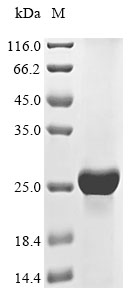This Recombinant Mouse Fgf20 protein was made through genetic engineering. By putting the Fgf20 gene into the genetic material of E.coli cell, the E.coli could be used as factories or producers to make the desired Fgf20 protein for research uses. The expression region of this protein is at 1-211aa. No tag was used in the expression process. The purity is 85%+ determined by SDS-PAGE.
Fibroblast growth factor 20 (FGF20), a member of the FGF family, is a paracrine growth factor whose orthologs are highly conserved among vertebrates. Human FGF20 is highly similar to rat FGF20 and mouse FGF20 (nearly 95% amino acid identity). FGF20, expressed mainly in the brain, has been suggested to be a critical factor involved in brain development and neuronal homeostasis. Reports identified the therapeutic effects of FGF20 on CNS conditions, PD and Alzheimer's disease. According to a previous study, rhFGF20 protected against BBB disruption by suppressing the inflammatory response, an effect that might be mediated through inhibition of the JNK and NF-κB signaling pathways. aFGF has been reported to inhibit the activity of JNK and NFκB through TAK/TAB to exert anti-inflammatory effects, and FGF21 can inhibit the JNK/NFκB pathway. The positive roles of FGF20 in Parkinson’s disease (PD) imply that it may play a neuroprotective role in other CNS disorders.






